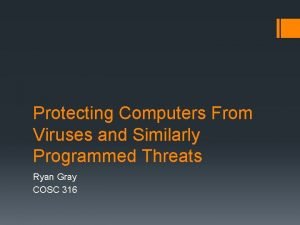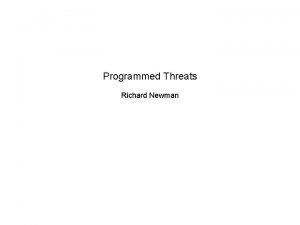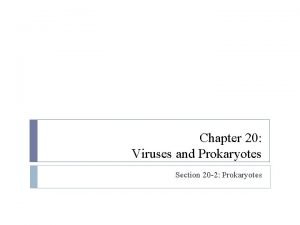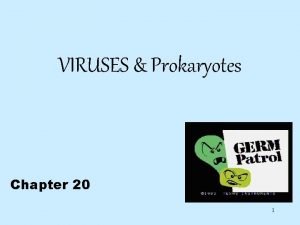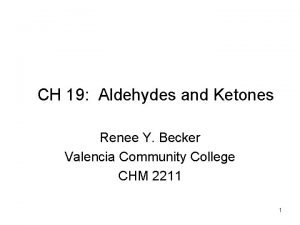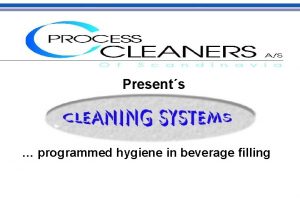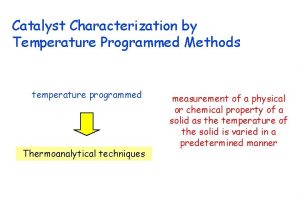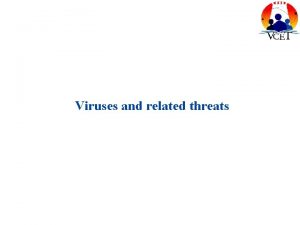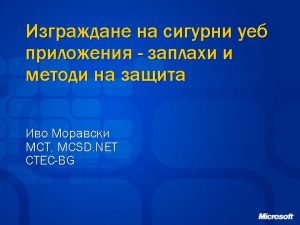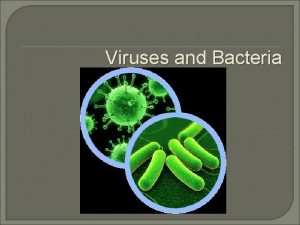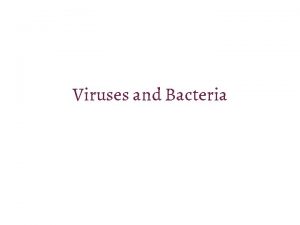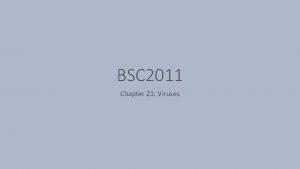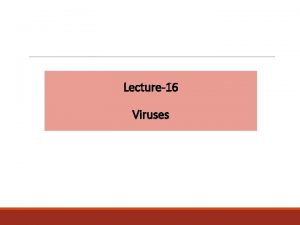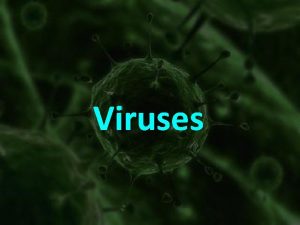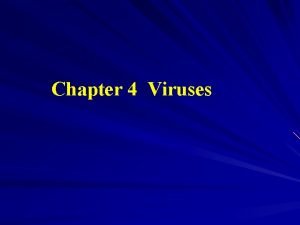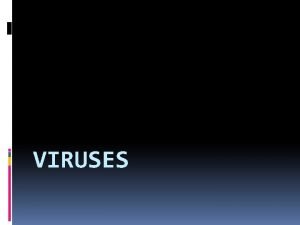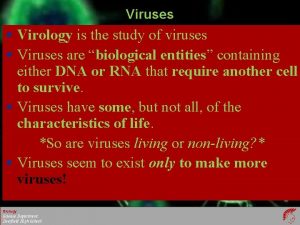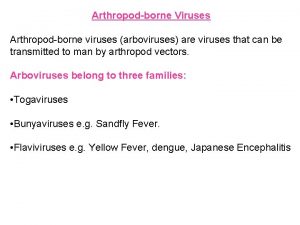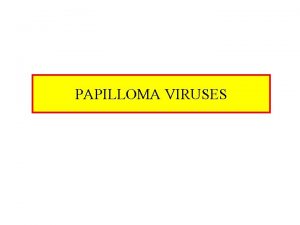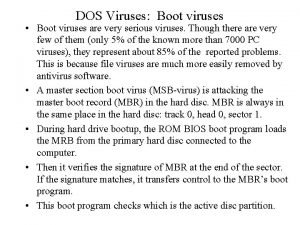Protecting Computers From Viruses and Similarly Programmed Threats




















![Signature-Based Example § Metamorphic viruses redefine themselves to avoid detection § § int[] new. Signature-Based Example § Metamorphic viruses redefine themselves to avoid detection § § int[] new.](https://slidetodoc.com/presentation_image/9b243282e68d916cec87f60e15d95516/image-21.jpg)











- Slides: 32

Protecting Computers From Viruses and Similarly Programmed Threats Ryan Gray COSC 316

Contents § Early virus protection software § Common malicious software § Notable viruses § Identification and deletion techniques § Pitfalls of each

Virus Protection Software § Used to prevent, detect, and remove malicious software § Began in 1980’s in research fields § BITNET/EARN network led to first open discussion of viruses § Mailing list included John Mc. Afee and Eugene Kaspersky

Early Viruses § Malicious code spread through infected floppy disks § Exploited boot sectors of hard drives and executables § Windows Autorun § Limited in scope § Could only damage the host system § No replication § Mostly macros

Internet Age § As the internet became popular, malicious software evolved § Often infected Windows and Microsoft products § Outlook § Word § Malicious software becomes self-replicating and mobile § Infected emails and attachments § Zero-day exploits

Common Malicious Software § Today malicious software has many names based on behavior § Malware, spyware, viruses, trojans, keyloggers, backdoors, rootkits, worms, adware

Notable Viruses and Worms § 1982 - Elk Cloner infected Apple II systems § 1990 - ILOVEYOU infects millions of Windows systems Worldwide § 2002 - Mylife first virus to send infected emails to all Outlook contacts § 2003 – SQL Slammer jams internet traffic worldwide by exploiting SQL Server § 2004 – Sasser exploits LSASS Windows service blocking internet traffic to government agencies and private corporations.

Elk Cloner

ILOVEYOU

Mylife

SQL Slammer

Sasser

Notable Continued § 2011 - Anti Spyware appears as a legitimate program but forces users to pay for removal § 2013 - Crypto. Locker trojan encrypts an important file on a computer and forces users to pay a ransom

Anti Spyware

Crypto. Locker

Identification and Deletion § Multiple techniques exist to identify and delete malicious software § In 1987, Fredrick Cohen demonstrates no algorithm is perfect to remove all malicious software § Signature-Based detection § Heuristics § Rootkit § Real-time Protection/Shield

Signature-Based § AVG’s and Avast! Methods § Constantly refresh virus definitions on host systems § Scan contents of files looking for known signatures § Quarantine or encrypt those files to render them inoperable

Signature-Based Example § Signatures are pieces of code stripped from known malicious software and stored for cross-referencing on host systems § AVG and Avast! maintain their own virus definitions

Signature-Based Example § Simplistic Example § Malicious software with these lines of code § § int[] example = new int[1000] int counter = 500 while(counter>0) example[counter] = some. Generic. Get()

Signature-Based Example § Anti-Virus software will (hopefully) identify this malicious code and take proper action § This technique is simple, efficient, and effective for most malicious code § Most, meaning it is easily defeated by modern metamorphic viruses
![SignatureBased Example Metamorphic viruses redefine themselves to avoid detection int new Signature-Based Example § Metamorphic viruses redefine themselves to avoid detection § § int[] new.](https://slidetodoc.com/presentation_image/9b243282e68d916cec87f60e15d95516/image-21.jpg)
Signature-Based Example § Metamorphic viruses redefine themselves to avoid detection § § int[] new. Example = new int[1000] int new. Counter = 500 while(new. Counter>0) new. Example[counter] = even. More. Generic. Get()

Signature-Based Example § The relationship between signature-based detection and false-positives inversely proportional § More strict and descriptive signatures throw more false-positives § Less strict signatures fail to detect known malicious code § Does not work on new malicious software as the signature does not yet exist in anti-virus definitions § Definitions must be constantly updated

Signature-Based

Real-Time Detection § To use Avast! as an example, uses multiple techniques to provide protection while the system is being used § On-access scanner § Real-Time shields and sandboxing § Firewalls

Realtime in Avast!

Scanners § Similar detection techniques previously mentioned § Signature-based, assuming a real-time shield failed § Sandboxing an executable § Analyze and/or disassemble program code to search for malicious modification of system files

Common Fallacies of Scanners § Scanning does NOT run every program on your drive and look for malicious intent § Scanners can only detect known viruses from definitions § If detected, viruses are not often deleted § Encrypted or moved § Memory/Flash scans are not reliable

Scanners

Sandboxing § Sandboxes are common in more fields than just security § For Windows compatible anti-virus programs § Emulate the OS with many of the same components § § Addressable memory OS Kernels Restricted network kernel that points to nowhere or is limited Mock system registry

Sandboxing Pitfalls § As with other methods, sandboxing has downsides § § § Memory heavy CPU heavy False-positives Delayed execution of new programs Installation hang-ups and errors

Sandboxing

Conclusion § Early virus protection software § Common malicious software § Notable viruses § Identification and deletion techniques § Pitfalls of each
 Lytic cycle animation
Lytic cycle animation Youtube
Youtube Programmed threats
Programmed threats Programmed threats
Programmed threats What is noninstallment credit
What is noninstallment credit Chapter 9 obtaining and protecting your credit
Chapter 9 obtaining and protecting your credit Chapter 9 obtaining and protecting your credit
Chapter 9 obtaining and protecting your credit Protecting consumers savers and investors examples
Protecting consumers savers and investors examples Section 19-3 diseases caused by bacteria and viruses
Section 19-3 diseases caused by bacteria and viruses Egrette chapter 21
Egrette chapter 21 Nonliving particle that replicates inside a living cell
Nonliving particle that replicates inside a living cell Bacteria and viruses chapter 7 lesson 1 answer key
Bacteria and viruses chapter 7 lesson 1 answer key Chapter 20 viruses and prokaryotes
Chapter 20 viruses and prokaryotes Chapter 18 section 1 bacteria
Chapter 18 section 1 bacteria Section 1 studying viruses and prokaryotes
Section 1 studying viruses and prokaryotes Chapter 20 civil liberties protecting individual rights
Chapter 20 civil liberties protecting individual rights Reactions of aldehydes and ketones summary
Reactions of aldehydes and ketones summary Aldehyde protecting group
Aldehyde protecting group Carbamate protecting group
Carbamate protecting group John procotr quotes
John procotr quotes Protecting student data
Protecting student data Biodiversity tends to decrease nearer the equator
Biodiversity tends to decrease nearer the equator Biodiversity
Biodiversity Chapter 20 civil liberties protecting individual rights
Chapter 20 civil liberties protecting individual rights Chapter 20 civil liberties protecting individual rights
Chapter 20 civil liberties protecting individual rights Programmed decision
Programmed decision Example of non programmed decision
Example of non programmed decision Counters in plc
Counters in plc Nano programming
Nano programming In managing attractions, a programmed decision is
In managing attractions, a programmed decision is Programmed decision
Programmed decision Classical administrative and political decision making
Classical administrative and political decision making Decision making under bounded rationality
Decision making under bounded rationality


